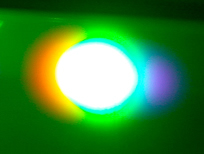Jan 6 2008
Having completed their work in summer 2007, the former partners of the EU-funded URANUS (Ultra-fast technology for multicolour compact high-power fibre systems) project want to continue their research. URANUS has been essential to advancing fibre laser technology in Europe.
 Photograph of the supercontinuum radiation generated in fibre tapers starting from green, dispersed on a diffraction grating.
Photograph of the supercontinuum radiation generated in fibre tapers starting from green, dispersed on a diffraction grating.
The two main goals of the project were to develop ultra-fast laser systems operating at different wavelengths, and to develop and test broadband fibre sources. 'Our research broke new ground,' project manager Dr Mircea Guina of Tampere University of Technology in Finland says. 'We have come a long way in recent years, but there are still many more areas to explore.'
As a matter of fact, the URANUS project successfully developed a so-called 'mode-locked' laser which uses a special fibre, ytterbium-doped photonic bandgap (Yb-PBG), which helps to compensate beam dispersion. This discovery contributed to the development of the first 'supercontinuum fibre laser'.
'The supercontinuum source can generate pulses at all wavelengths,' explains Professor Oleg Okhotnikov, the coordinator of the URANUS project. 'For example, in the case of medical imaging you can select the wavelength you need from the broadband spectrum to detect a specific type of chromophore attached to a cancer cell.'
So far, commercial ultra-fast lasers have been based on solid-state technology, using air to carry the high-intensity light instead of optical fibre. However, these lasers tend to be larger and more expensive when it comes to production and maintenance costs than fibre lasers. 'Fibre is more efficient than air at getting the light to its target so it needs less power to achieve the same results as solid-state systems. It is also more stable and robust,' Prof. Okhotnikov says.
'Fibre lasers could replace solid-state lasers for most uses, as well as open the door to new applications,' adds Dr Guina, predicting that ultra-fast fibre lasers will play a key role in machining even smaller nanotechnology systems and in demonstrating practical new applications, such as optical coherence tomography, a 3D digital imaging technique used in medicine, among many other applications.
The URANUS project received nearly €1.5 million in funding under the EU's Sixth Framework Programme (FP6), and brought together six partners from four European countries.